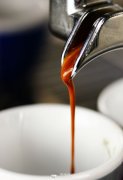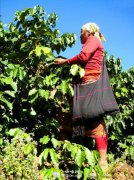Coffee knowledge the brewing method of high-quality coffee
1. Pressure infiltration:
When the 91 degrees Celsius water comes into contact with the coffee powder, the soul of the coffee begins to wake up…This is a direct presentation of the true color of the coffee beans, showing the essence of the coffee beans and the degree of roasting, the easiest and least skilled brewing method, the so-called "lazy coffee". Pour coffee powder into a glass jug with a press filter on top, heat for about 4 minutes, press the press lever slowly to remove coffee grounds and drink.
2. Siphon:
The most dramatic part of the process of turning coffee beans into coffee is that when the water rises, you will hold your breath and wait for the moment when it becomes coffee to fall. This is the classical and never popular method of coffee extraction.
Siphon coffee pot with the use of siphon principle, boiling hot water rushed to coffee powder, stew coffee flavor.
3. Drip filtration:
Vietnamese coffee brewing method, originated in France, easy to operate. Add the coffee powder to the filter paper on the funnel; heat the water until the coffee powder is soaked; all the hot water flows into the pot and you can drink it.
4. Italian:
Each cup of Espresso(Italian concentrated) extraction is a dialogue between classical technology and modern technology. The appearance and taste of each cup of Espresso is also the general report of coffee bean physical examination. This is a high-pressure way, let the steam quickly through the coffee powder, extract the strong coffee, add the coffee powder to the middle coffee tray, add water to the lower pot, close the upper and lower pots, heat until all the water in the lower pot evaporates, pour out and drink.
5. Hand punch:
First warm the coffee cup and brewing equipment, fold along the bottom edge and side sewing line of the filter paper, open the filter paper and install it on the filter cup, pour the coffee powder into the filter paper, and shake the filter cup left and right to make the coffee powder surface flat, evenly and slowly wet the coffee surface with hot water of about 90 degrees Celsius, steam for 20-30 seconds, 2-3 times from the center to the periphery, and then slowly inject hot water from the periphery to the center.
6. Autofiltration:
Drip coffee machine, hot water driven by electricity, steams to release coffee essence.
Important Notice :
前街咖啡 FrontStreet Coffee has moved to new addredd:
FrontStreet Coffee Address: 315,Donghua East Road,GuangZhou
Tel:020 38364473
- Prev

Italian coffee, double espresso.
Basically, this is a specially male drink, energetic and unhypocritical, and an enhanced version of kung fu coffee for real coffee ghosts. Double does not mean doubling the amount of coffee, but the same amount of water, double the amount of coffee powder, coffee still looks like that, but the concentration has doubled. The level is equivalent to the essence of spirits and perfumes in alcohol.
- Next

Brief introduction of Coffee knowledge Coffee planting techniques
1. The cultivation of strong coffee seedlings 1. The selection of nursery land is close to water source, convenient for transportation, loam or sandy loam with loose and fertile soil, deep soil layer, good drainage, paddy field with PH value of 66.5 or early nursery land, and close to coffee garden. Turn over 20cm30cm meters to make fire and burn the soil, hoe fine and remove stones, branches and roots before sieving, or use mountain humus, add 8-
Related
- Beginners will see the "Coffee pull flower" guide!
- What is the difference between ice blog purified milk and ordinary milk coffee?
- Why is the Philippines the largest producer of crops in Liberia?
- For coffee extraction, should the fine powder be retained?
- How does extracted espresso fill pressed powder? How much strength does it take to press the powder?
- How to make jasmine cold extract coffee? Is the jasmine + latte good?
- Will this little toy really make the coffee taste better? How does Lily Drip affect coffee extraction?
- Will the action of slapping the filter cup also affect coffee extraction?
- What's the difference between powder-to-water ratio and powder-to-liquid ratio?
- What is the Ethiopian local species? What does it have to do with Heirloom native species?

